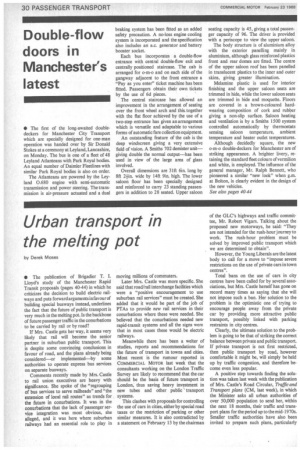Double-flow doors in Manchester's latest
Page 32

If you've noticed an error in this article please click here to report it so we can fix it.
• The first of the long-awaited doubledeckers for Manchester City Transport which are specially designed for one-man operation was handed over by Sir Donald Stokes at a ceremony at Leyland, Lancashire, on Monday. The bus is one of a fleet of 48 Leyland Atlanteans with Park Royal bodies. An equal number of Daimler Fleetlines with similar Park Royal bodies is also on order.
The Atlanteans are powered by the Leyland 0.680 engine with semi-automatic transmission and power steering. The transmission is air-pressure actuated and a dual braking system has been fitted as an added safety precaution. A no-loss engine cooling system is incorporated and the specification also includes an ac. generator and battery booster socket.
Each bus incorporates a double-flow entrance with central double-flow exit and centrally positioned staircase. The cab is arranged for o-m-o and on each side of the gangway adjacent to the front entrance a "Pay as you enter" ticket machine has been fitted. Passengers obtain their own tickets by the use of 6d pieces.
The central staircase has allowed an improvement in the arrangement of seating over the front wheel arch and this, together with the flat floor achieved by the use of a two-step entrance has given an arrangement which is versatile and adaptable to various forms of automatic fare collection equipment.
An outstanding feature of the cab is the deep windscreen giving a very extensive field of vision. A Smiths 702 demister unit— giving double the normal output—has been used in view of the large area of glass involved.
Overall dimensions are 31ft 6in, long by 8ft 2+in, wide by 14ft 9in. high. The lower saloon floor has been specially designed and reinforced to carry 23 standing passengers in addition to 28 seated. Upper saloon seating capacity is 45, giving a total passenger capacity of 96. The driver is provided with a periscope to view the upper saloon.
The body structure is of aluminium alloy with the exterior panelling mainly in aluminium, although glass reinforced plastics front and rear domes are fitted. The centre of the upper saloon roof has been panelled in translucent plastics to the inner and outer skins, giving greater illumination.
Melamine plastic is used for interior finishing and the upper saloon seats are trimmed in hide, while the lower saloon seats are trimmed in hide and moquette. Floors are covered in a brown-coloured hardwearing composition of cork and rubber giving a non-slip surface. Saloon heating and ventilation is by a Smiths 1500 system controlled automatically by thermostats sensing saloon temperature, ambient temperature and heater outlet temperatures.
Although decidedly square, the new o-m-o double-deckers for Manchester are of striking appearance. A brighter livery, retaining the standard fleet colours of vermilion and white, is employed. The influence of the general manager, Mr. Ralph Bennett, who pioneered a similar "new look" when g.m. at Bolton, is clearly evident in the design of the new vehicles.
See also pages 40-44










































































































